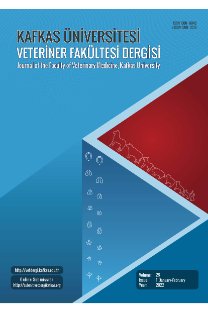Köpeklerde femur ve tibia diyafizinin deneysel maddi kayıplı kırıklarında ulna distalinin seğmental kortikal otogref olarak kullanımı
Bu çalışmada değişik ırk, yaş, cinsiyet ve ağırlıkta 12 köpek kullanıldı. Köpekler 6'şar adetlik iki gruba ayrılarak bir grupta femur diyafizincle, diğer grupta ise tibia diyafizinde 2 cm uzunluğunda defekt oluşturuldu. Metal plaka kullanılarak korunan defektler, ulna' nın distalinden alınan silindirik şekilli kortikal otogrefler ile dolduruldu. Olguların 15 gün aralıklarla klinik ve radyografık kontrolleri yapılarak 6 aylık sürede iyileşmenin olup olmadığı belirlenmeye çalışıldı, iyileşen hayvanlarda gref uygulanan bölgelerin histopatolojik kontrollerinin yapılması amaçlandı. Ancak klinik ve radyolojik bulgulara göre komplikasyon şekillenen (pseudoartroz, fistül gibi) bazı hayvanlar (6 adet) değişen sürelerde ötenazi edildi. Kontrol süresi sonunda kalan hayvanlarda gref uygulanan bölgelerin histopatolojik muayeneleri yapıldı. Klinik olarak 2 olguda opefasyon bölgesinde fistül oluşumu gözlendi. 10 olguda değişen derecelerde topallıklar gözlenirken, 2 olguda topallık belirlenmedi. Radyografik değerlendirmelerde, 3 olguda vidalarda gevşeme, 2 olguda plakada kırılma ve l olguda pseudoartroz saptandı. Altı aylık inceleme sürelerini tamamlayan olguların yapılan histopatolojik incelemelerinde, fibröz doku oluşumu yanında yeni kemik oluşumunun da şekillenmeye başladığı belirlendi. Bu çalışma sonucunda köpeklerde femur ve tibianın maddi kayıplı diyafizer defektlerinde ulnanın distalinden alman silindirik şekilli kortikal otogreflerin beklenen iyileşmeyi sağlamadığı ve dolayısıyla kullanışlı olmadığı kanısına varıldı.
Use of the distal portion of ulna as a segmental cortical autograft for experimentally induced fractures with large bone defect on the diaphysis of the tibia and femur in dogs
This study was conducted on 12 dogs differing in races, ages, sexes and weights. These dogs, were divided into two equal groups and 2 cm long defect was performed experimentally on the diaphysis of the femur of group 1 and the diaphysis of the tibia of group 2. The fracture defects were filled with cylindrical shaped cortical autograft obtained from the distal part of the ulna and then these grafts were secured in place using a metal plate. The day of healing was tried to be determined by clinic and radiographie examination of these cases with 15 days intervals, ît was aimed to carry out histopathologic examination of graft applied regions of the healed cases. However, some animals (6 cases) having complication (e.g. pseudoarthrosis, fistula) according to the result of the clinic and radiographie examinations were euthanized in different time periods. Those animals survived during the follow-up period were used for histopathologic examination. , , Clinically, operation site fistula in 2 cases were determined. While 10 cases presented the different degrees .of lameness, 2 cases were free from it. Radiographically, dislodgement of screws in 3 cases, plate fracture in 2 cases and pseudoarthrosis in 1 case were determined, Histopathologic examination in cases survived during 6 months follow-up period showed fibreuse tissue development associated with new bone formation. Finally, there was no expected healing response from cylinder shaped cortical autografts taken from the distal portion of ulna for the repairmen! of the defects of femur and tibia fractures associated with large bone defect and thus they were considered to be unsuitable for this particular purpose.
